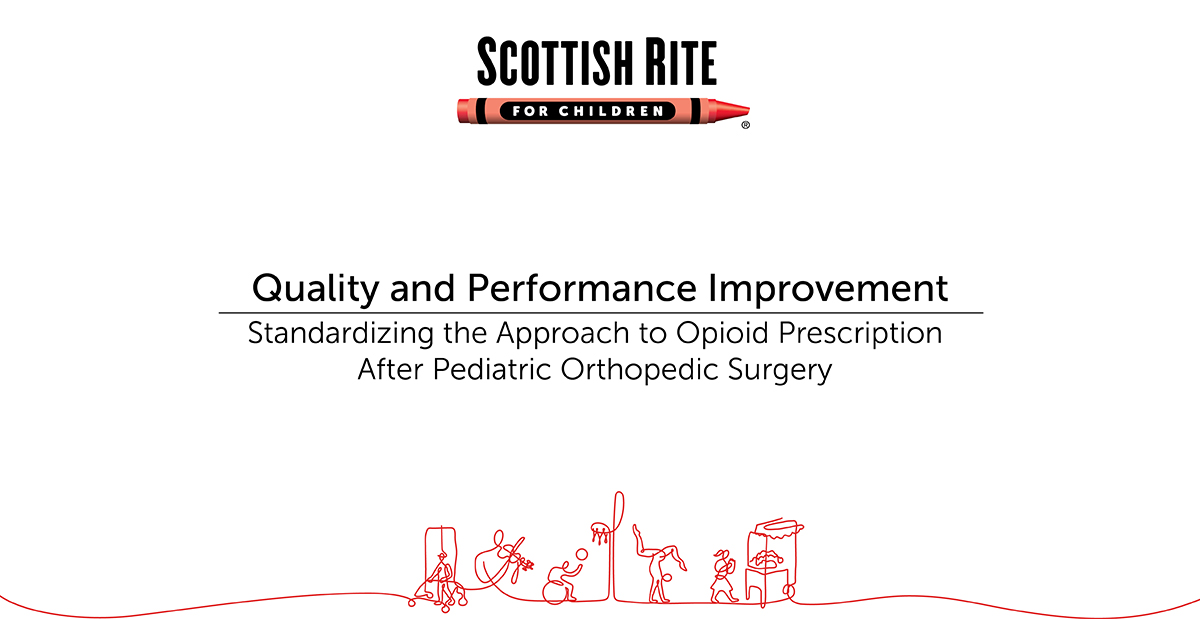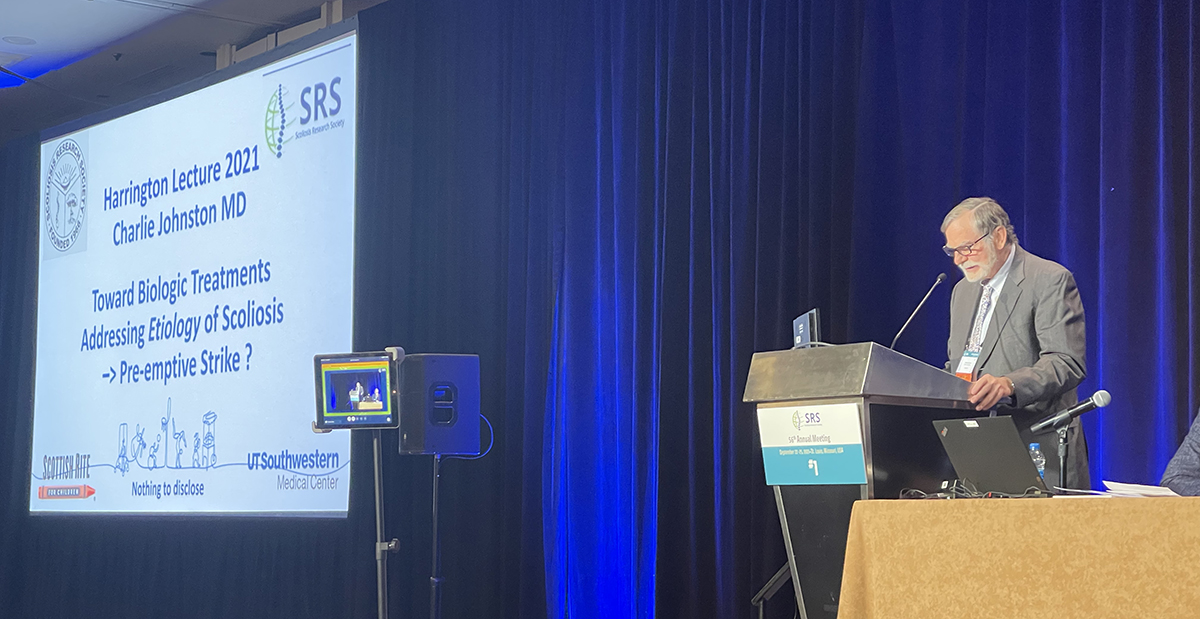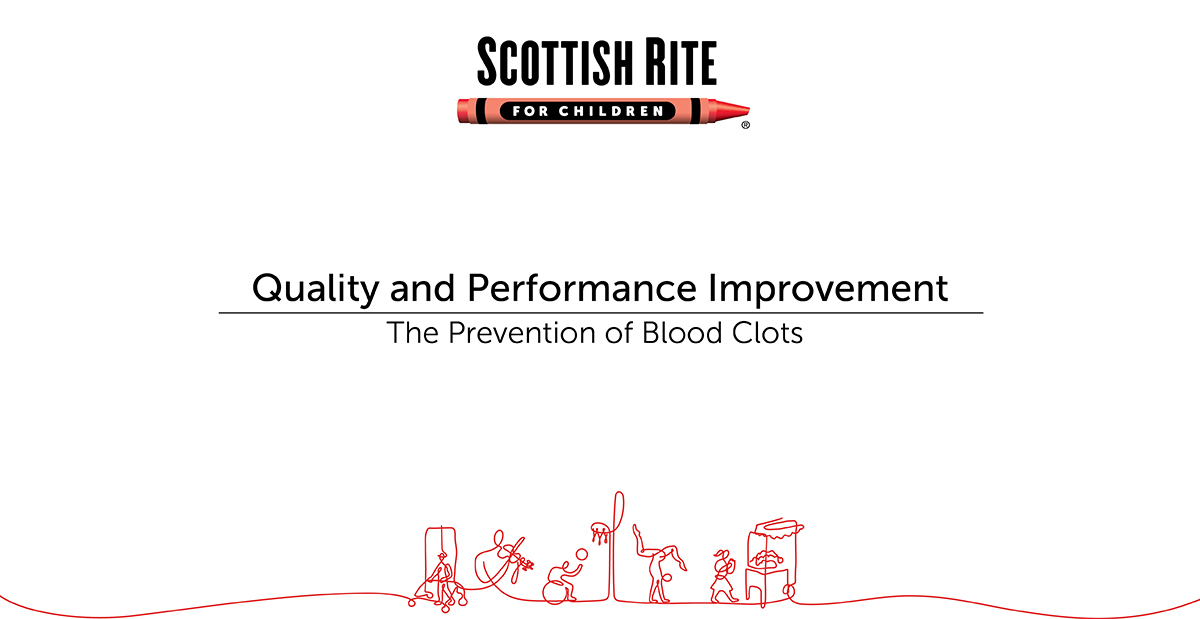
May 10, 2021 / General News
Standardizing the Approach to Opioid Prescription After Pediatric Orthopedic Surgery
There has been a steady increase in the abuse of prescription opioid (narcotic) medications contributing to the “opioid crisis.” Orthopedists are the fourth leading prescriber of opioids in the United States. Pharmacist, Stacie Bukowsky, R.Ph., says, “Exposure and access to opioids as a child or teen are associated with use or abuse of opioids in the future. As a pediatric orthopedic provider, we acknowledge our role to impact this concern in our community by formally evaluating our past performance and adjusting our processes to ensure we are prescribing the smallest, effective dose.”
What is Scottish Rite doing to address opioid prescription in pediatric orthopedics?
Senior program manager of the Clinical Quality and Performance Improvement department, Charu Sharma, M.H.A., M.S., CSSBB, CPHQ says, “We began a quality improvement project to assess historic prescription trends and patient satisfaction regarding postoperative pain to identify opportunities to reduce variability in our processes.”
This project initially focused on a specific surgical population. Bukowsky says, “Patients with idiopathic scoliosis are among our healthiest patients making them an ideal population for our retrospective review.” Chart review of 99 patients with idiopathic scoliosis undergoing a surgical procedure, posterior spinal fusion (PSF), between May and November of 2017 demonstrated a wide range of opioid prescribing practices upon hospital discharge. The project found that postoperative prescriptions ranged from 50-100 doses per patient. With the average prescription less than 50 and patient survey data to support effectiveness of the dosing, the team suspected that prescribing more than that was not necessary. Results from a patient survey to assess satisfaction with pain control helped to assess the effectiveness of the quantity prescribed.
Physician champion and pediatric orthopedic surgeon Brandon A. Ramo, M.D., led representatives from pharmacy, inpatient and ambulatory nursing, quality and electronic medical record (EMR) design teams using continuous improvement strategies like plan-do-study-act (PDSA) cycles. The team identified and tested interventions to standardize the number of opioid doses prescribed at discharge after PSF surgery.
During PDSA cycle #1, the following interventions were tested:
What has been accomplished so far?
As a result of this ongoing quality improvement initiative, average opioid dose prescribed has improved to an average 36 doses (range from 10 – 53). The patient survey results indicate more satisfied patients with better pain control, reduced narcotic use and better disposal options for left over narcotics. Less than 10% of patients inquired about a refill, according to Bukowsky, who is passionate about this initiative.
What does this mean for pain management in pediatric orthopedics?
A standardized approach to opioid prescribing and family education after PSF allows for reduction in variability and average number of doses while maintaining adequate pain control. Based on the results from this population-specific project, the team has now developed a pediatric orthopedic postoperative discharge prescription guideline to expand the benefits to patients undergoing other procedures.
How does Scottish Rite plan to sustain the progress made?
Including our EMR design team from the beginning of a project like this allows for a faster turnaround when implementing clinical findings into operational standardization and efficiency. From best practice alerts for prescriptions outside of range to customizing discharge order sets in the EMR, the positive efforts to standardize the process are more likely to be lasting and to continue to improve. Additionally, the EMR can support a critical step to measure and monitor over time.
Our team presented this novel project and results as an electronic poster titled “Implementation of Standardized Discharge Regimen and Education Reduces Narcotic Prescribing Following Adolescent Idiopathic Scoliosis (AIS) and Juvenile Idiopathic Scoliosis (JIS) Surgery” at the Pediatric Orthopaedic Society of North America (POSNA) annual meeting in 2020.
What is Scottish Rite doing to address opioid prescription in pediatric orthopedics?
Senior program manager of the Clinical Quality and Performance Improvement department, Charu Sharma, M.H.A., M.S., CSSBB, CPHQ says, “We began a quality improvement project to assess historic prescription trends and patient satisfaction regarding postoperative pain to identify opportunities to reduce variability in our processes.”
This project initially focused on a specific surgical population. Bukowsky says, “Patients with idiopathic scoliosis are among our healthiest patients making them an ideal population for our retrospective review.” Chart review of 99 patients with idiopathic scoliosis undergoing a surgical procedure, posterior spinal fusion (PSF), between May and November of 2017 demonstrated a wide range of opioid prescribing practices upon hospital discharge. The project found that postoperative prescriptions ranged from 50-100 doses per patient. With the average prescription less than 50 and patient survey data to support effectiveness of the dosing, the team suspected that prescribing more than that was not necessary. Results from a patient survey to assess satisfaction with pain control helped to assess the effectiveness of the quantity prescribed.
Physician champion and pediatric orthopedic surgeon Brandon A. Ramo, M.D., led representatives from pharmacy, inpatient and ambulatory nursing, quality and electronic medical record (EMR) design teams using continuous improvement strategies like plan-do-study-act (PDSA) cycles. The team identified and tested interventions to standardize the number of opioid doses prescribed at discharge after PSF surgery.
During PDSA cycle #1, the following interventions were tested:
- Standardized opioid discharge regimen: maximum of 45 doses, education and plan to taper and discontinue opioid pain medicine over 10 days (or before).
- Education to medical staff, orthopedic residents and fellows.
- Pharmacist led the development of new patient education materials to explain tapering and encourage non-narcotic medications like ibuprofen and Tylenol®.
- Implemented a “double-check” by pharmacist when greater than 45 doses were ordered.
- Based on the conclusions from that effort, a second PDSA cycle was undertaken with only one significant change. The maximum recommended doses number was lowered from 45 down to 40. Updates were made to the tapering guideline and patient/family education material.
What has been accomplished so far?
As a result of this ongoing quality improvement initiative, average opioid dose prescribed has improved to an average 36 doses (range from 10 – 53). The patient survey results indicate more satisfied patients with better pain control, reduced narcotic use and better disposal options for left over narcotics. Less than 10% of patients inquired about a refill, according to Bukowsky, who is passionate about this initiative.
What does this mean for pain management in pediatric orthopedics?
A standardized approach to opioid prescribing and family education after PSF allows for reduction in variability and average number of doses while maintaining adequate pain control. Based on the results from this population-specific project, the team has now developed a pediatric orthopedic postoperative discharge prescription guideline to expand the benefits to patients undergoing other procedures.
How does Scottish Rite plan to sustain the progress made?
Including our EMR design team from the beginning of a project like this allows for a faster turnaround when implementing clinical findings into operational standardization and efficiency. From best practice alerts for prescriptions outside of range to customizing discharge order sets in the EMR, the positive efforts to standardize the process are more likely to be lasting and to continue to improve. Additionally, the EMR can support a critical step to measure and monitor over time.
Our team presented this novel project and results as an electronic poster titled “Implementation of Standardized Discharge Regimen and Education Reduces Narcotic Prescribing Following Adolescent Idiopathic Scoliosis (AIS) and Juvenile Idiopathic Scoliosis (JIS) Surgery” at the Pediatric Orthopaedic Society of North America (POSNA) annual meeting in 2020.



